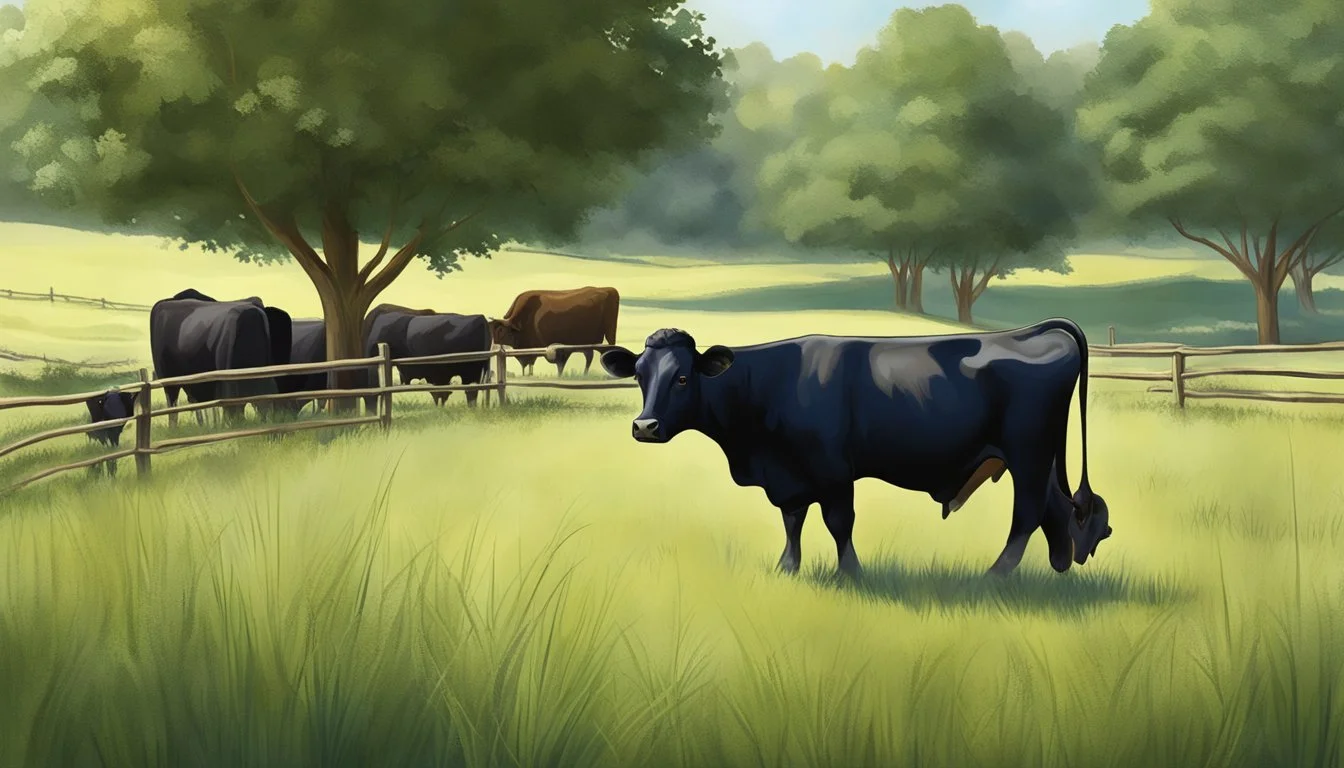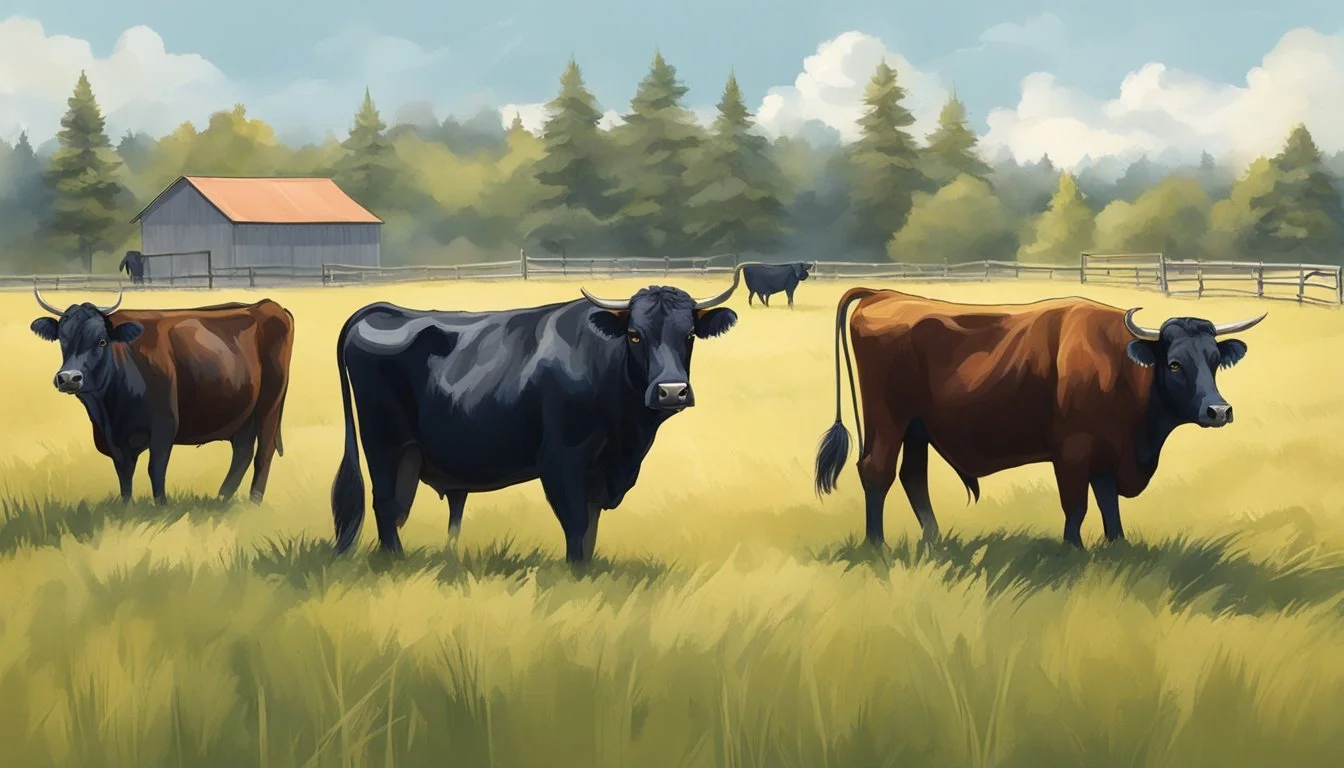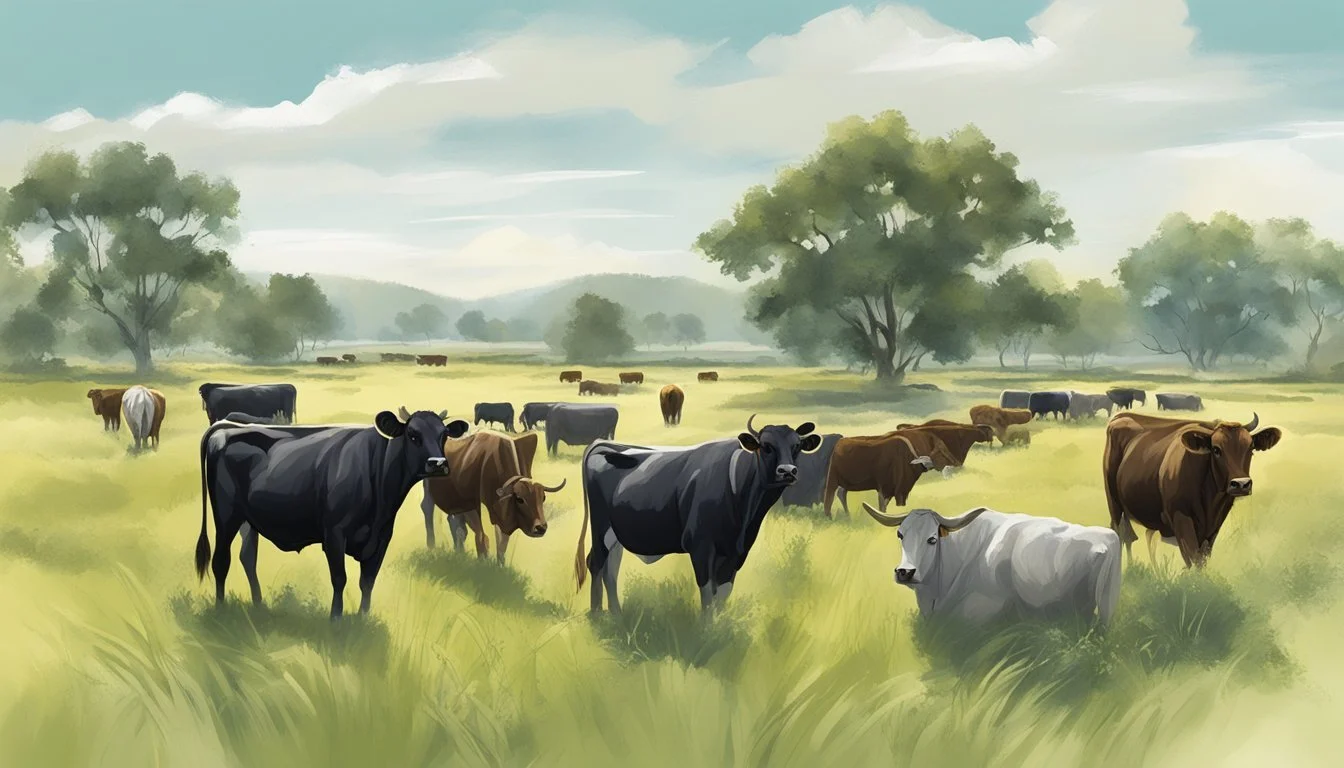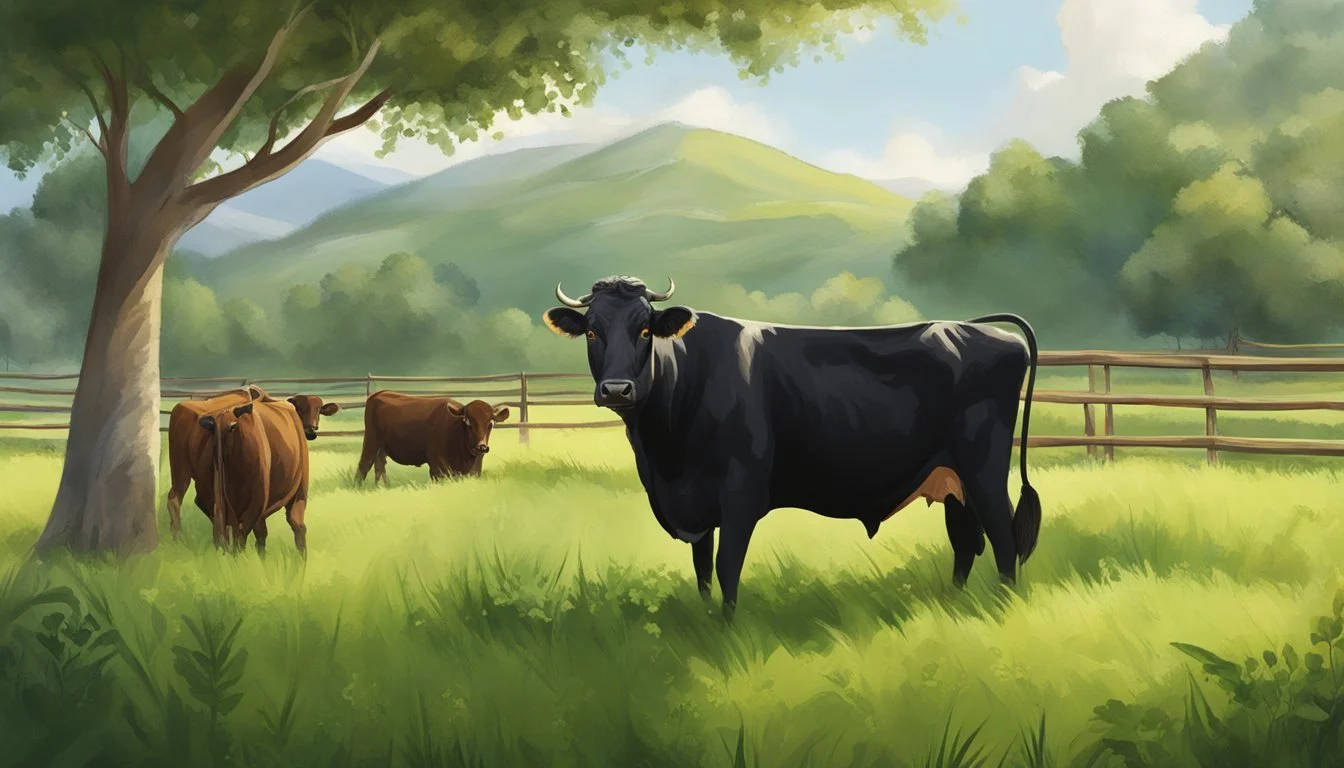Dexter Cattle Feeding Guide
Nutritional Needs and Best Practices for Pasture Management
Dexter cattle, originally from Ireland, are compact and efficient breed that has gained popularity for their dual-purpose capabilities in both milk and meat production. Adapted for both small-scale and larger operations, they are particularly lauded for their hardiness and ability to thrive on relatively limited acreage. When feeding Dexter cattle, their nutritional intake primarily relies on grazing, and they are well-suited to grass-fed systems. Managing a well-maintained pasture to provide their main source of nutrition is essential, with an area of one to two acres usually sufficient to sustain a small herd of these cattle.
While Dexters are predominantly raised on pastures, their dietary needs may change according to the season. During the more fruitful growing seasons, lush grass will often suffice, but in the winter months, when pastures can no longer sustain them, their diet needs to be supplemented. Hay or grain becomes necessary to maintain the health and condition of the cattle. Given their smaller size compared to standard cattle breeds, the amount of supplemental feed required is less, which reduces the overall feeding costs.
Pasture management is crucial not only for the health of the Dexter cattle but also for the sustainability of the farming operation. It requires a strategic approach that involves regular monitoring and rotational grazing to prevent overgrazing and the degradation of grasslands. Providing additional minerals and supplements might also be necessary to balance their diet and ensure the herd's optimal health and productivity. Dexter cattle's efficient feed conversion, smaller size, and lower maintenance make them particularly suitable for grass-based systems and smallholdings, aligning with environmentally conscious and sustainable farming practices.
Nutritional Requirements
A well-balanced diet that meets nutritional requirements is crucial for the health and productivity of Dexter cattle. These cattle need a careful balance of macronutrients for energy, proteins for growth and repair, and a well-defined suite of vitamins and minerals for overall physiological functions.
Macronutrients and Energy
Dexter cattle require energy primarily sourced from carbohydrates in their diet, which typically come from grass, hay, or grains. The nutrient supply for energy should be consistent to avoid weight loss or gain that can affect their health and productivity.
Carbohydrates: The main source of energy; found in pasture grasses and hay.
Fats: Provide a concentrated energy source; usually present in small amounts in standard cattle feeds.
Protein and Amino Acid Needs
Protein is essential for growth, reproduction, and repair of tissues. Dexter cattle require diets with adequate protein levels to ensure optimal health and performance. Nutritional management should ensure that protein intake is sufficient to meet their development and maintenance needs.
Protein Content: A range of 10-15% in their diet, depending on the age and production stage.
Amino Acids: Essential amino acids must be available in the diet for proper body function.
Vitamins and Minerals
Vitamins and minerals are vital for the immune system, bone structure, and other bodily functions in Dexter cattle.
Macrominerals: Such as calcium and phosphorus, should be maintained at proper ratios.
Trace Minerals: Include elements like zinc and selenium, which are critical in smaller quantities.
Vitamins: Especially A, D, and E, are needed for various metabolic functions.
Feeding Management
Effective feeding management for Dexter cattle ensures a well-balanced diet that promotes health and productivity. Accurate assessment of feed quality, strategic supplementation, and regulating feeding frequency and quantities are crucial for optimizing nutrient intake and managing feed costs.
Assessing Feed Quality
Feed quality is critical for cattle health and production. Forage should be tested for nutritional content, as it is the primary source of nutrients for Dexter cattle. Laboratories can analyze sample feeds to determine their nutrient profile, including protein, energy, fiber, vitamins, and minerals. Higher quality forage not only meets the nutritional needs better but also reduces the reliance on expensive supplements.
Supplementation Strategies
Supplementation addresses nutritional gaps in Dexter cattle diets, especially when grazed forage quality is low or during periods of higher nutritional need such as growth or lactation. Supplements can include:
Protein: Essential for growth and repair, and can be given in the form of soybean meal or other protein-rich feeds.
Minerals and Vitamins: Vital for bodily functions, with common supplements including calcium and phosphorus.
The strategy should consider the cost of supplements and their contribution to the overall nutrient intake. Over-supplementation is to be avoided as it increases feed costs without corresponding benefits.
Feeding Frequency and Quantities
Dexter cattle's intake should be consistent with their body weight and production stage. Generally, they consume about 2.0%-2.3% of their body weight in dry matter daily. Feeding frequency should align with the natural grazing patterns, while quantities should be adjusted based on the quality of pasture:
Lactating cows and growing calves may require more frequent and higher volume feeding.
In winter, when forage is scarce, increased feeding frequencies with supplemental hay or grain may be necessary.
Managing feeding carefully ensures cattle meet their nutritional needs without incurring unnecessary feed costs.
Pasture and Grazing Management
Effective pasture and grazing management is vital for maintaining pasture quality and meeting the nutritional needs of Dexter cattle. It involves strategic planning of forage selection and understanding seasonal patterns to optimize pasture productivity.
Pasture Quality and Composition
Pasture quality is defined by the health of the plants and the soil's ability to support various management practices. The composition of a pasture should include a mix of forage grasses and legume species to provide a balanced diet, improve soil conditions, and enhance overall pasture productivity. It's essential to consider the soil's nutrient requirements and match them with appropriate forage species that thrive in the local climate and environmental conditions.
Ideal forage species for Dexter cattle:
Grasses: Timothy, Bermuda grass, Tall fescue
Legumes: Clover, Alfalfa
Soil conditions should be regularly monitored to maintain pasture health, with attention given to pH levels and nutrient content.
Grazing Systems and Techniques
Different grazing systems can be implemented depending on the stocking rate, resource availability, and environmental conditions.
Continuous grazing: Cattle have unrestricted access to a pasture for a long period.
Rotational grazing: Livestock moves between paddocks to allow forage regrowth.
Rotational grazing improves forage utilization and can support a higher stocking rate by allowing pastures adequate recovery time.
Grazing Rotation and Seasonality
Grazing rotation involves moving cattle between paddocks to prevent overgrazing and allow for forage growth. This practice can be tailored to the grazing season, taking into account the growth rates of forages, which vary with the seasons.
Example grazing rotation schedule:
Month: April - May, Paddock Number: 1 - 2, Notes: Rapid spring growth
Month: June - July, Paddock Number: 3 - 4, Notes: Growth slows; manage forage quality
Month: Aug - Sept, Paddock Number: 5 - 6, Notes: Prepare for fall regrowth
Grazing rotations should be flexible to adjust to changing weather patterns and forage conditions, ensuring that cattle have access to high-quality forage throughout different seasons.
Herd Health and Welfare
In managing Dexter cattle, the primary health and welfare concerns focus on meeting nutritional needs to support body condition, reproductive efficiency, and the overall care of calves from birth. Assessing these factors is crucial for herd productivity and sustainability.
Body Condition Scoring
Body condition scoring (BCS) is an essential tool for managing the nutritional status of Dexter cattle. A numerical scale, often from 1 (emaciated) to 9 (obese), helps farmers assess the energy reserves of an animal. Optimal BCS targets for Dexters are usually between 5 and 7 to ensure good reproductive performance and minimize issues such as dystocia, which is difficult calving often related to poor BCS or excessive birth weight.
Reproductive Health
Fertility and reproductive health are critical for herd productivity. Monitoring estrus and ensuring first-calf heifers and mature cows are in peak condition for the breeding season can enhance reproductive performance. Nutritional management tailored to reproductive stages supports stronger estrus expression and better fertility rates, thus contributing to a more uniform and successful calving season.
Calving and Calf Care
The calving process and subsequent calf care are vital to maintaining a healthy Dexter herd. Providing rich colostrum within the first few hours of life is imperative to boost the calf's immune system. Vigilance during the calving season is key to identifying and managing any calving difficulties, such as dystocia, and ensuring that calves reach a healthy weaning weight. Adequate nutrition and management are also necessary to support the additional demands on first-calf heifers during this time.
Breed Characteristics and Genetics
In discussing Dexter cattle, their compact size and versatility stand at the forefront, with genetic traits significantly influencing their husbandry and breeding practices.
Understanding Dexter Cattle
Dexter cattle are one of the smallest true breeds of cattle, known for their hardiness and adaptability. They hail from Ireland and have made a name for themselves as dual-purpose animals suitable for both milk and meat production. Typically, Dexter bulls weigh between 1,000 to 1,200 pounds, while cows range from 750 to 850 pounds. These cattle can be either horned or polled, with some farmers preferring the latter for ease of handling.
Size: Smaller stature, about half the size of a traditional Hereford.
Usage: Dual-purpose, raised for both milk and meat.
Physical Characteristics:
Horn Status: Can be horned or polled.
Weight: Bulls: 1,000-1,200 lbs; Cows: 750-850 lbs.
Genetic Traits and Breeding
Genetically, Dexter cattle are known for their efficient feed conversion and genetic potential for longevity and good health. They possess a remarkable ability as mothers, often calving with ease and raising their calves with minimal intervention. Breeding Dexter cattle requires an understanding of these genetic markers to maintain the breed's desirable traits. As draft animals, their strength despite their size is also a genetic quality that bespeaks their versatility.
Health: Hardy, with a good genetic potential for longevity.
Mothering: Excellent maternal instincts; calve easily.
Breeding: Knowledge of genetics is key to maintaining breed standards.
When managing Dexter cattle, recognizing and fostering their genetic traits ensures a thriving, productive herd. Employing selective breeding strategies can help maintain the robustness and utility that Dexter cattle are celebrated for.
Environment and Adaptability
Dexter cattle's feeding and health are influenced by their environment and adaptability. These aspects are integral to proper pasture management and ensuring that the nutritional needs of the cattle are met.
Climate Considerations
Dexter cattle are hardy animals capable of adapting to a wide range of climate conditions. However, their nutritional requirements fluctuate with changes in temperature and humidity. In colder climates, they require more energy-dense feed to maintain body temperature and thrive. Conversely, in hotter and more humid conditions, their feed intake might decrease, and they would seek shaded areas to mitigate heat stress.
Utilizing Marginal Lands
These cattle excel at utilizing less fertile, marginal lands for grazing, which may not be suitable for other agricultural purposes. Their smaller size and efficient grazing habits enable them to thrive on varied pastures that larger breeds might struggle with. Marginal lands with proper management can fulfill a significant portion of the Dexter cattle's dietary needs, reducing the reliance on supplemental feed.
Shelter and Housing Requirements
While Dexter cattle are relatively robust and can withstand various environmental conditions, providing adequate shelter can help maintain their health and productivity. Shelter and housing should protect the cattle from extreme weather conditions ranging from high heat, cold, to wet environments. Such structures don't need to be elaborate but must offer relief from environmental stressors, ensuring that the cattle have a place to rest and stay dry or cool, depending on the weather.
Economic Aspects of Dexter Cattle Farming
Dexter cattle farming presents a distinctive economic profile due to the breed's adaptability and dual-purpose potential. These cattle offer peculiar advantages in both beef and dairy production, influencing feed costs and market opportunities.
Feed Costs and Profit Margins
Dexter cattle are well-known for their efficient feed conversion, which can lead to more affordable feed costs when compared to larger beef cattle breeds. Despite their smaller size, they maintain a body condition easily, which is beneficial for both beef and milk production. Farmers find that grazing Dexters can significantly reduce feed costs, owing to the breeds' ability to thrive on pasture-based diets. However, careful management of pasture and possible supplemental feeding with grains can affect the profit margins. A balanced approach to feeding can result in a healthy cow herd, improved milk production in dairy operations, and a substantial meat yield for beef producers.
Pasture: Lower cost, requires effective pasture management.
Grain Supplementation: Higher cost, may increase weight gain and milk yield.
Profit Margins: Influenced by feed efficiency, market prices for beef and milk, and herd management costs.
Market Demand and Opportunities
The market for Dexter cattle, both as beef breeds and dairy animals, is niche but growing. Farmers can tap into the demand for high-quality, grass-fed beef, which Dexters can provide. Additionally, Dexters produce a sufficient quantity of rich, creamy milk, appealing to local dairy markets and artisanal cheese producers. Market opportunities may also arise from selling breeding stock to other farmers looking to benefit from the breed's economical attributes. Diversifying products to include beef, milk, and breeding stock can open multiple revenue streams for farmers.
Beef Market: Dexter cattle are ideal for niche grass-fed beef markets.
Milk Market: Their milk's high butterfat content is perfect for boutique dairies or cheese production.
Breeding Stock: Sale of Dexters for breeding purposes can be profitable if well-managed.
Sustainable Practices
Dexter cattle owners can enhance the environmental and nutritional outcomes of their livestock by adopting sustainable practices in pasture management.
Pasture Improvement and Manure Management
Pasture improvement plays a critical role in increasing forage quality and quantity for Dexter cattle. Owners should consider implementing rotational grazing, which promotes regrowth and maintains an evenly distributed high protein content in the forage. It helps to ensure a consistent supply of fresh grass, which is essential for cattle requiring a diet rich in high protein content.
Manure management is a crucial aspect of sustainable practice. Dexter cattle manure contributes nitrogen to the soil, benefiting pasture health and forage quality but must be managed correctly to prevent nutrient runoff. By systematically rotating grazing areas and evenly distributing manure, farmers turn waste into a resource, fostering a healthy pasture ecosystem.
Conservation and Biodiversity
Conservation of the environment is an inherent part of sustainable farming practices. Dexter cattle, often in solid colors, are hardy and able to thrive on less fertile land, thereby reducing the need to convert wild areas into pasture. Integrating native plant species into pastures not only supports local wildlife and plant biodiversity but also provides a varied diet for the cattle, which can improve the protein content of the forage.
Implementing practices like buffer zones around water bodies and selective breeding to maintain the genetic diversity of livestock herds also contribute to conservation efforts. These practices help sustain the ecosystem and ensure the long-term viability of agricultural activities through a balance between livestock needs and environmental stewardship.
Supplementary Feeding and Nutrition
Dexter cattle require a balanced diet to meet their nutritional needs, especially during stages like weaning and lactation. Supplementary feeding complements pasture grazing, ensuring adequate weight gain and overall health.
Utilizing Crop Residues
Crop residues, such as corn stalks or wheat straw, can be an economical feed resource for Dexter cattle, particularly after weaning. They must carefully consider the nutritional value of these residues, as they primarily offer fiber and few other nutrients. To make the best use of crop residues for supplementation:
Analyze the residue for nutrient content.
Ensure adequate protein supplementation as the residue alone will not suffice.
Creating a Balanced Supplementation Program
Developing a supplementation program for Dexters involves providing nutrients not adequately available from pasture or crop residues. A balanced program takes into account:
The stages of the cattle's production cycle, particularly lactation, which demands higher nutrients.
The existing diet's nutrient profile to avoid over- or under-supplementation.
For grain supplementation:
Introduce grain into the diet gradually to prevent digestive issues.
Use grains to enhance energy intake for cattle in need of weight gain.
Supplemental feed should complement, not replace, main feedstuffs to maintain a cost-effective nutrition program.
Special Considerations
When feeding Dexter cattle, it is critical to make adjustments to their diet throughout different life stages and to manage their feed intake based on environmental conditions. Nutrient requirements vary, and achieving optimal health and reproductive performance depends on careful attention to these factors.
Dietary Adjustments for Life Stages
Dexter cattle necessitate distinct dietary compositions during various life stages to meet their changing nutrient demands. For example, during lactation, cows have a heightened need for protein and energy to support milk production. Ensuring that lactating cows receive adequate nutrition is crucial not only for the volume but also the nutritional value of the milk, which impacts calf health. Newborn calves depend on colostrum, the first milk, for a vital intake of nutrients and antibodies.
Reproductive performance in Dexter cattle is influenced by diet. Females should receive a balanced diet to maintain the proper condition for conception and carrying a calf. Moreover, the nutritional status of the cow can affect the birth weight of the calf, which is an important determinant of calf viability.
Managing Feed Intake in Varying Conditions
Feed intake in Dexter cattle should be managed to accommodate different environmental conditions while satisfying the herd's nutrient demand. During cold months when pasture is limited, providing supplemental hay or grain is critical to maintain cattle health. On the other hand, overfeeding can result in obesity, which can adversely affect reproductive performance. It's essential to strike a balance:
Winter: Supplement with hay or grains as required.
Drought Conditions: Provide alternative feedstuffs to compensate for pasture scarcity.
Monitoring the cattle’s body condition score regularly helps customize feeding programs to sustain health and productivity regardless of changing environmental conditions.







